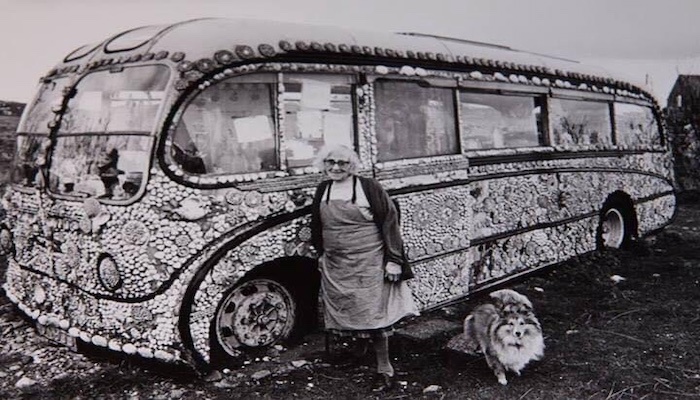
Flora Johnstone

Flora Johnstone (1899-1992) created art that is iconic to South Uist and represents the close relationship between the people and their homeland. The Scottish government recognised and recorded her remarkable shell art which she had stuck onto the exterior walls of her house at Bualadubh, Iochdar, through its Canmore records. This was after she had decorated an old school bus, that she purchased for £5 from Lachlan MacLeod, in the late 1950’s. She used it as a spare room and then a greenhouse. Once it started to deteriorate she decided to cover it in shells to make it look better. She had many lying around as cockles were part of the families stable diet. Visitors began to come and see this extraordinary bus and asked if she had any trinkets to sell, so then she began making ornaments to display and sell in the bus.
Origins of the Shell Bus
Hear from Margaret Gray and Oni Fraser, Flora’s daughter and granddaughter on the origins and uses of the shell bus.
The Shell Bus

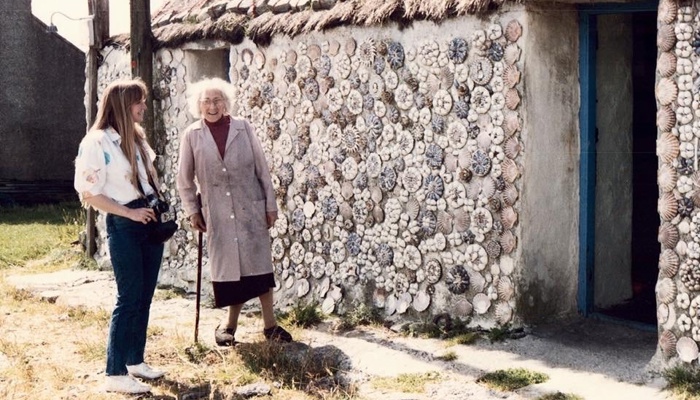
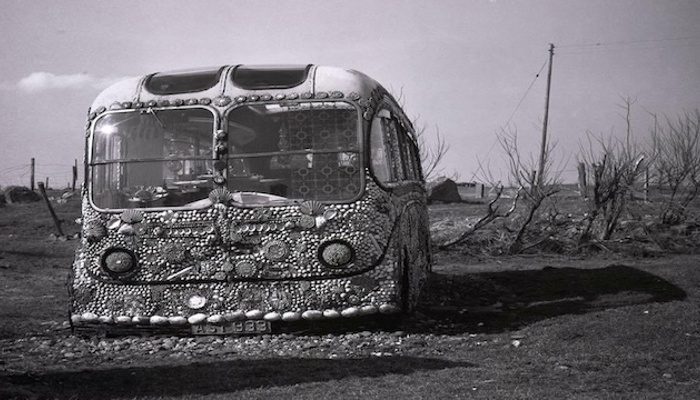
‘……b’ e boireannach trang a bh’ innte daonnan. Fiù’s nuair a bha sinn a’ fàs suas bhiodh i a’ fighe agus a’ fuine agus ag obair air a’ chruit agus a’ dèanamh iomadh rud, agus bha beairt aice, dhèanadh i clò.Agus bu toil leatha a gàradh…oh cho miosail sa bha i air a gàradh. Bha gàradh àlainn aice, bha mòran glasraich a’ fàs ann, b’ i a chiad neach ann an Uibhist a bha a’ fàs tomàtothan’.
Margaret Gray, Flora’s Daughter
The shells for her art came from local nearby beaches, and her family and community collected them for her. The shells are commonly mussels, cockles and whelks. The money raised was donated to the Multiple Sclerosis Society, which her husband Lachlan had suffered from until his passing in 1968. They had been married in Glasgow in 1925. Lachlan and Flora were born in Ardmore, Iochdar. Flora went off to Glasgow to find work at Maceys as their cook and Lachlan joined the Cameron Highlanders, after he was wounded at the Somme he stayed in Glasgow to find work, where their paths crossed again and romance blossomed. The first of their 8 children was born in Glasgow but the family returned to Loch Carnan where their next two sons were born before finally moving to Buladubh where their five daughters were born. Whilst Lachlan worked the croft and taught piping, Flora bought a loom, making tweed – literally taking it from the sheep’s back and turning it into a jumper. As well as this she had an unusual vegetable garden growing plants such as strawberries, celery and herbs, and the bus became the first greenhouse for tomatoes in Uist. Flora kept in contact with her old employers in Glasgow and set up a barter system where she would send chickens, eggs, shellfish and vegetables on the Oban ferry in return for goods such as sugar, spices and anything else she couldn’t source in Uist . She also had this system running with Macleod’s the tea merchants where she sent them her tea coupons and they supplied her with tea. Flora was amazingly resourceful and ensured her family were well provided for – making sure nothing went to waste!
The art work begun in the 1970s and soon her fame and reputation grew as a tourist ‘must see’. Her family had long left the Island and Flora started to decorate her cottage using the same style as the bus. Representatives of the bus makers came to see her as did those of the evo-stik glue company. Everyone was amazed.
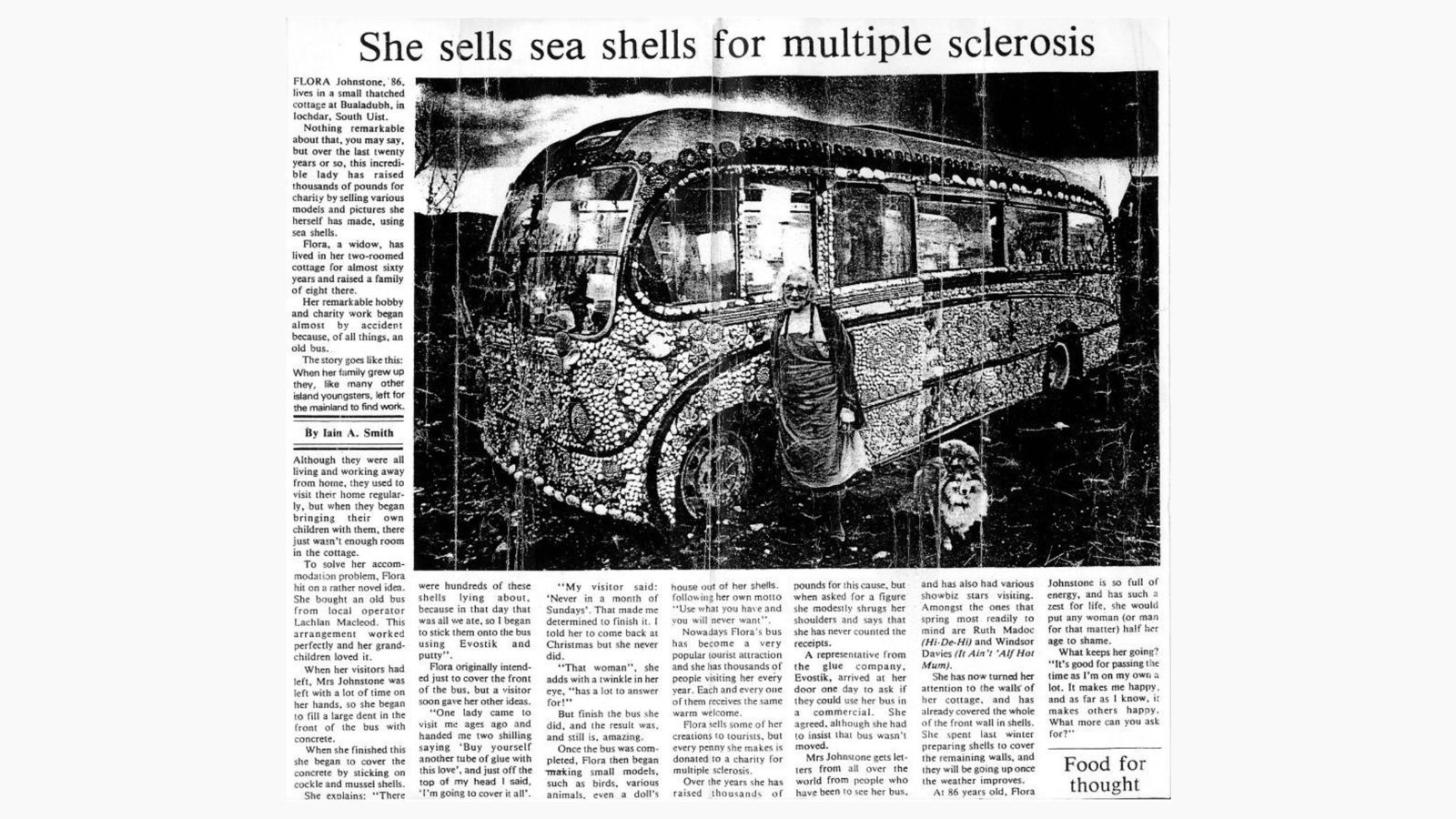
Hear more about Flora's art and love of shells
Margaret Gray, Flora’s daughter talking about the shells.
The glue company recommended that the glue Flora used should not be used outdoors but Flora just laughed and carried on. Seven years later the shells kept stuck. Today, in Glasgow Museum’s collection, the shells keep on being stuck and you can see some of these on the gallery page. Flora stuck them onto tin lids which she reused making different sizes of circular patterned shell art which are sometimes set in geometric or regular patterns. The trinkets offered representations of wildlife, like seals.
It was possibly through the news Flora’s art generated, tourism and Joyce Laing’s work with Angus MacPhee and knowledge of South Uist that Joyce learnt of Flora’s work and visited her house and bus. Joyce may have been attracted by the scale and skill of Flora’s work. Who else covers their house with tin lids covered in shells? It fitted the ‘Art Extraordinary’ bill because it was extraordinary art, as well as offering another shell protecting render to her property. We do not know when this was but by the 1980s the house and bus were deteriorating in condition and it could be that Joyce picked up examples of the circular shell sculptures which had fallen away or that she asked to take examples having asked permission.
Flora Johnstone was in no way in need of mental health care. She was a remarkable woman who made people happy and smile with her art. This was deeply connected with the area where she lived. It, like her house and life, were of the island, her family and community’s helping one another and others in need. She had a miniature Shetland dog called Shell which seems a very appropriate name!
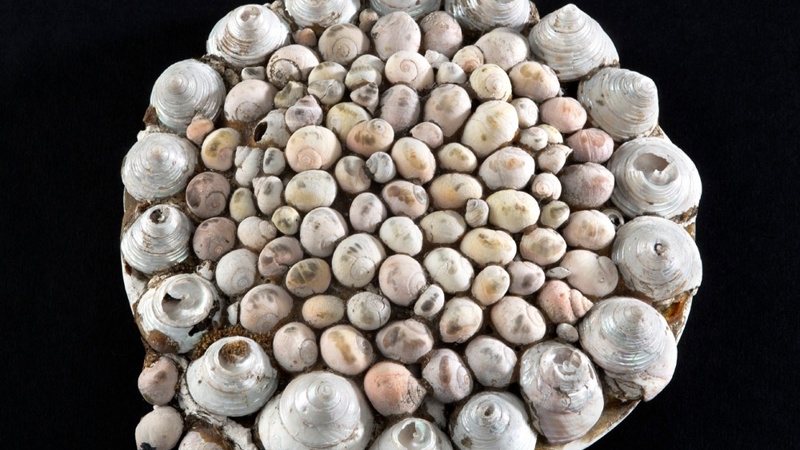
Flora's shell art
Tin lid decorated with eighteen larger shells on the outer edge and smaller shells in the centre and moss, by Flora Johnstone, ID number, A.2012.4.910, Gift from The Art Extraordinary Trust, Pittenweem, Fife, 2012
Flora Johnstone Gallery